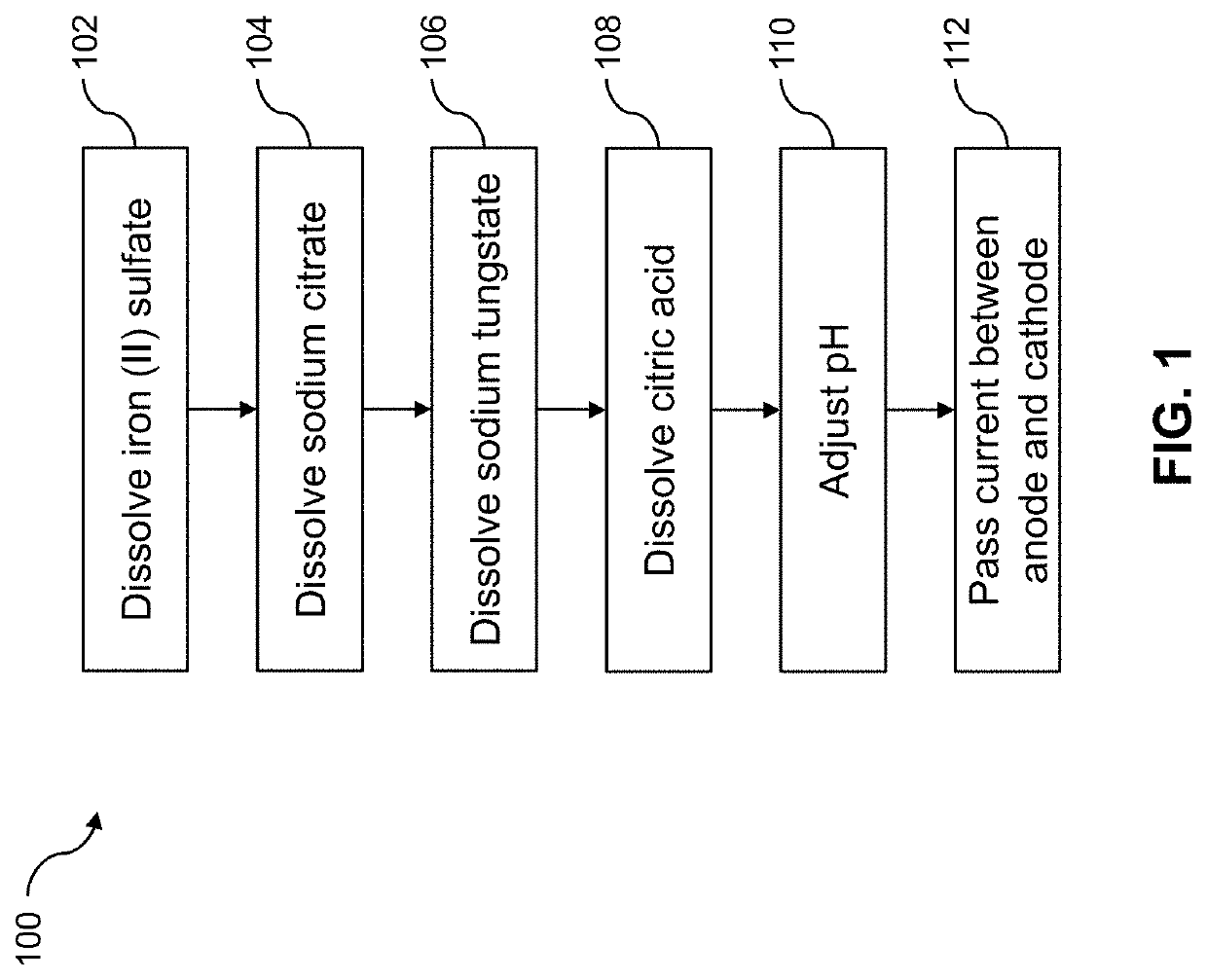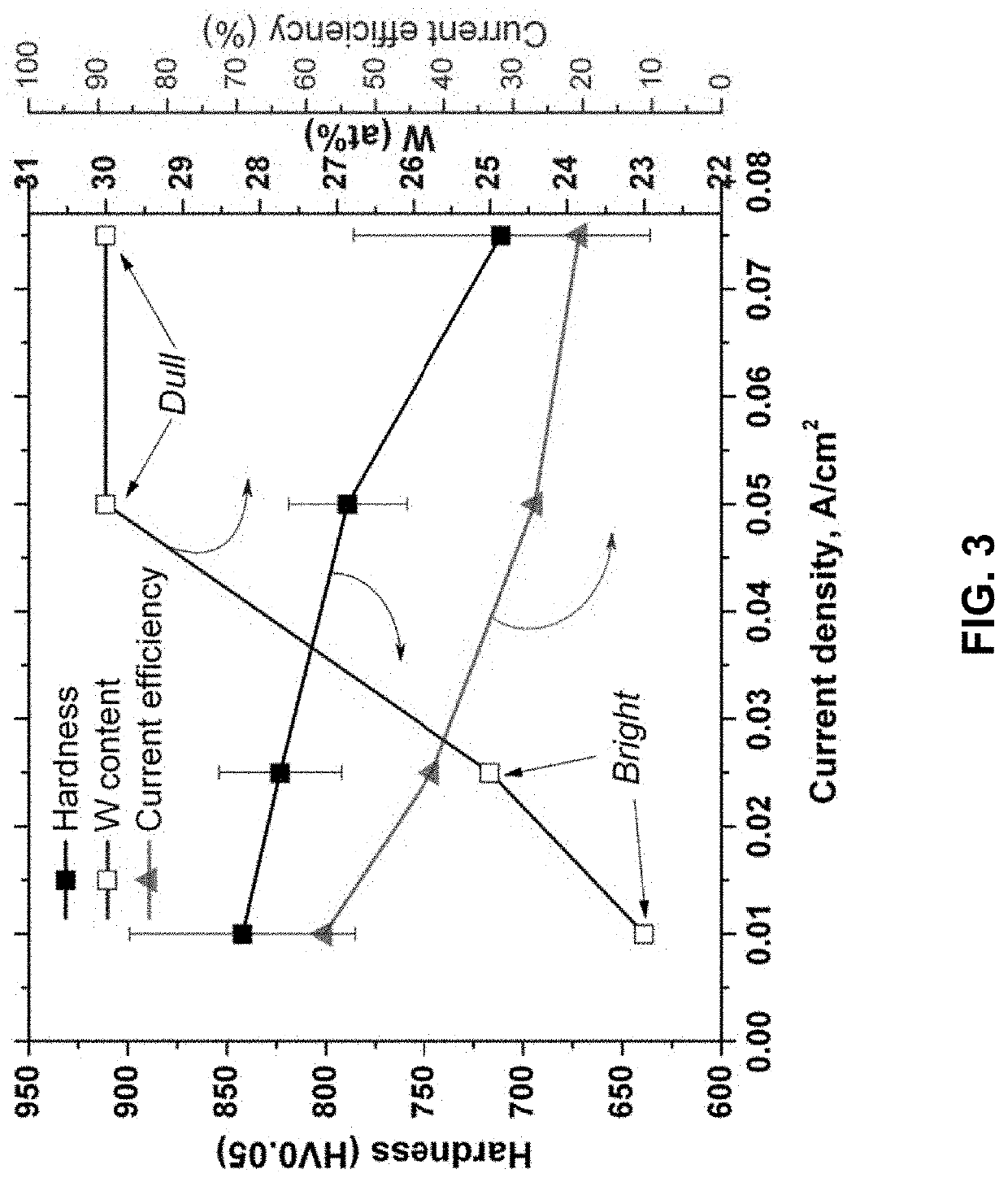Iron tungsten coating formulations and processes
a technology of iron tungsten and coating formulation, applied in the field of coatings, can solve the problems of difficult to provide thicker, hard, functional chrome coatings, etc., and achieve the effect of cost-effective, effective and efficient providing dull coatings
- Summary
- Abstract
- Description
- Claims
- Application Information
AI Technical Summary
Benefits of technology
Problems solved by technology
Method used
Image
Examples
example 1
[0089]Iron (II) sulfate heptahydrate in the amount of about 30 g (about 0.11 mol) per liter of electrolyte solution to be formed is dissolved in water, which results in a light green solution. Although iron (II) sulfate heptahydrate was used in this example, one or more other divalent iron salts (e.g., iron (II) sulfate with other hydration state, iron (II) bromide, iron (II) chloride, iron (II) iodide, iron (II) nitrate, iron (II) acetate, iron (II) perchlorate, or other divalent iron salt) can be used instead of, or in addition to, chromium (III) chloride. Then, sodium citrate dihydrate in the amount of about 85 grams (about 0.29 mol) per liter of the electrolyte solution to be formed is dissolved in the light green solution, which results in a dark green solution. Although sodium citrate dihydrate was used in this example, one or more other alkali metal citrates (e.g., sodium citrate with other hydration state, other trisodium citrate, disodium hydrogen citrate, sodium dihydrogen...
example 2
[0090]The resulting electrolyte solution of Example 1 was pH adjusted to about 7.5. A mild steel substrate was plated by passing a direct current using a platinized titanium mesh anode. The current density was maintained at about 0.01 A / cm2, the temperature was maintained at about 60° C., and the pH was maintained at about 7.5. The pH adjustment may be done, for example, by adding small amounts of sodium hydroxide, potassium hydroxide or sulphuric acid. A bright hard coating was formed on the mild steel substrate as shown in FIG. 12A. A scanning electron microscopy (SEM) image of the bright hard coating of FIG. 12A is shown in FIG. 13A. FIG. 14 shows an SEM image of a cross-section of a mild-steel substrate 1402 with a bright hard coating 1404. Bright hard coating 1404 is dense and compact.
example 3
[0091]The resulting electrolyte solution of Example 1 was pH adjusted to about 7.5. A mild steel substrate was plated by passing a direct current using a platinized titanium mesh anode. The current density was maintained at about 0.025 A / cm2, the temperature was maintained at about 60° C., and the pH was maintained at about 7.5. A bright hard coating was formed on the mild steel substrate. An SEM image of the bright hard coating is shown in FIG. 13B.
PUM
| Property | Measurement | Unit |
|---|---|---|
| current density | aaaaa | aaaaa |
| temperature | aaaaa | aaaaa |
| concentration | aaaaa | aaaaa |
Abstract
Description
Claims
Application Information
 Login to View More
Login to View More - R&D
- Intellectual Property
- Life Sciences
- Materials
- Tech Scout
- Unparalleled Data Quality
- Higher Quality Content
- 60% Fewer Hallucinations
Browse by: Latest US Patents, China's latest patents, Technical Efficacy Thesaurus, Application Domain, Technology Topic, Popular Technical Reports.
© 2025 PatSnap. All rights reserved.Legal|Privacy policy|Modern Slavery Act Transparency Statement|Sitemap|About US| Contact US: help@patsnap.com



